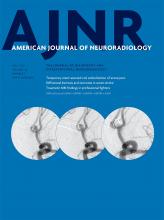Abstract
BACKGROUND: Concerns have arisen about the long-term health effects of repeat gadolinium injections in patients with multiple sclerosis and the incomplete characterization of MS lesion pathophysiology that results from relying on enhancement characteristics alone.
PURPOSE: Our aim was to perform a systematic review and meta-analysis analyzing whether noncontrast MR imaging biomarkers can distinguish enhancing and nonenhancing brain MS lesions.
DATA SOURCES: Our sources were Ovid MEDLINE, Ovid Embase, and the Cochrane data base from inception to August 2016.
STUDY SELECTION: We included 37 journal articles on 985 patients with MS who had MR imaging in which T1-weighted postcontrast sequences were compared with noncontrast sequences obtained during the same MR imaging examination by using ROI analysis of individual MS lesions.
DATA ANALYSIS: We performed random-effects meta-analyses comparing the standard mean difference of each MR imaging metric taken from enhancing-versus-nonenhancing lesions.
DATA SYNTHESIS: DTI-based fractional anisotropy values are significantly different between enhancing and nonenhancing lesions (P = .02), with enhancing lesions showing decreased fractional anisotropy compared with nonenhancing lesions. Of the other most frequently studied MR imaging biomarkers (mean diffusivity, magnetization transfer ratio, or ADC), none were significantly different (P values of 0.30, 0.47, and 0.19. respectively) between enhancing and nonenhancing lesions. Of the limited studies providing diagnostic accuracy measures, gradient-echo-based quantitative susceptibility mapping had the best performance in discriminating enhancing and nonenhancing MS lesions.
LIMITATIONS: MR imaging techniques and patient characteristics were variable across studies. Most studies did not provide diagnostic accuracy measures. All imaging metrics were not studied in all 37 studies.
CONCLUSIONS: Noncontrast MR imaging techniques, such as DTI-based FA, can assess MS lesion acuity without gadolinium.
ABBREVIATIONS:
- FA
- fractional anisotropy
- GRE
- gradient recalled-echo
- MD
- mean diffusivity
- MTR
- magnetization transfer ratio
- MWF
- myelin water fraction
- QSM
- quantitative susceptibility mapping
- SMD
- standardized mean difference
- © 2017 by American Journal of Neuroradiology
Indicates open access to non-subscribers at www.ajnr.org












